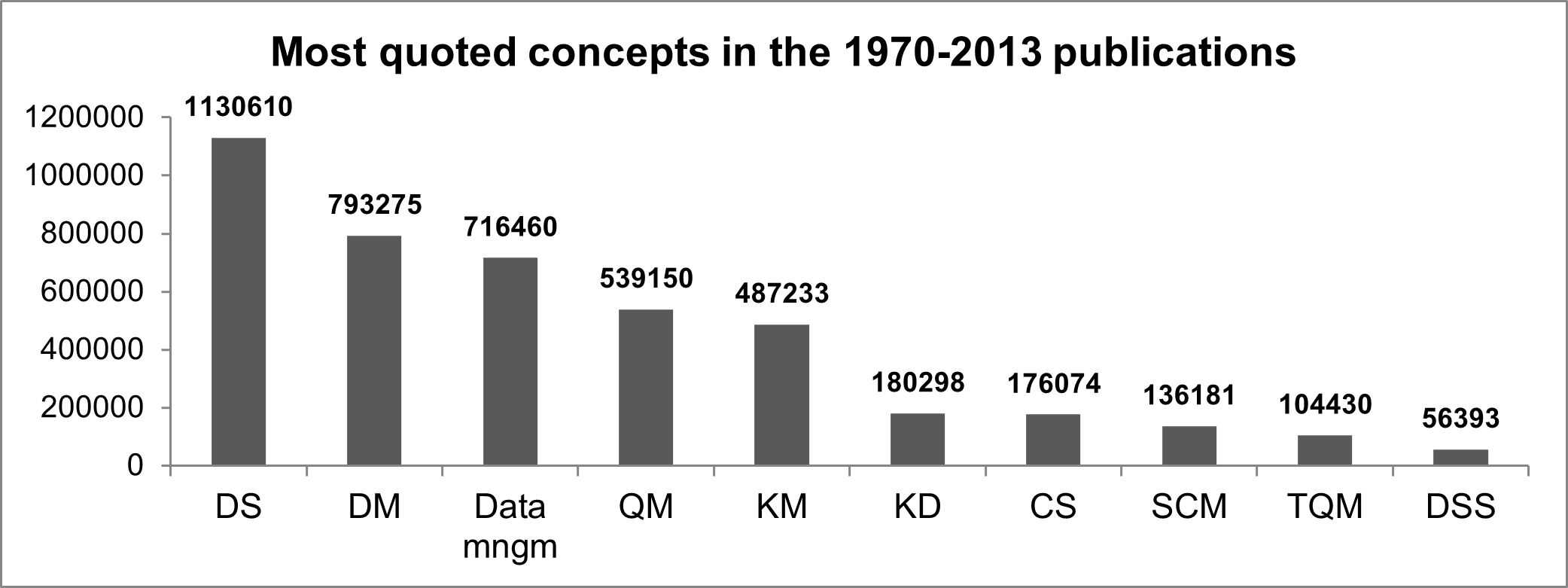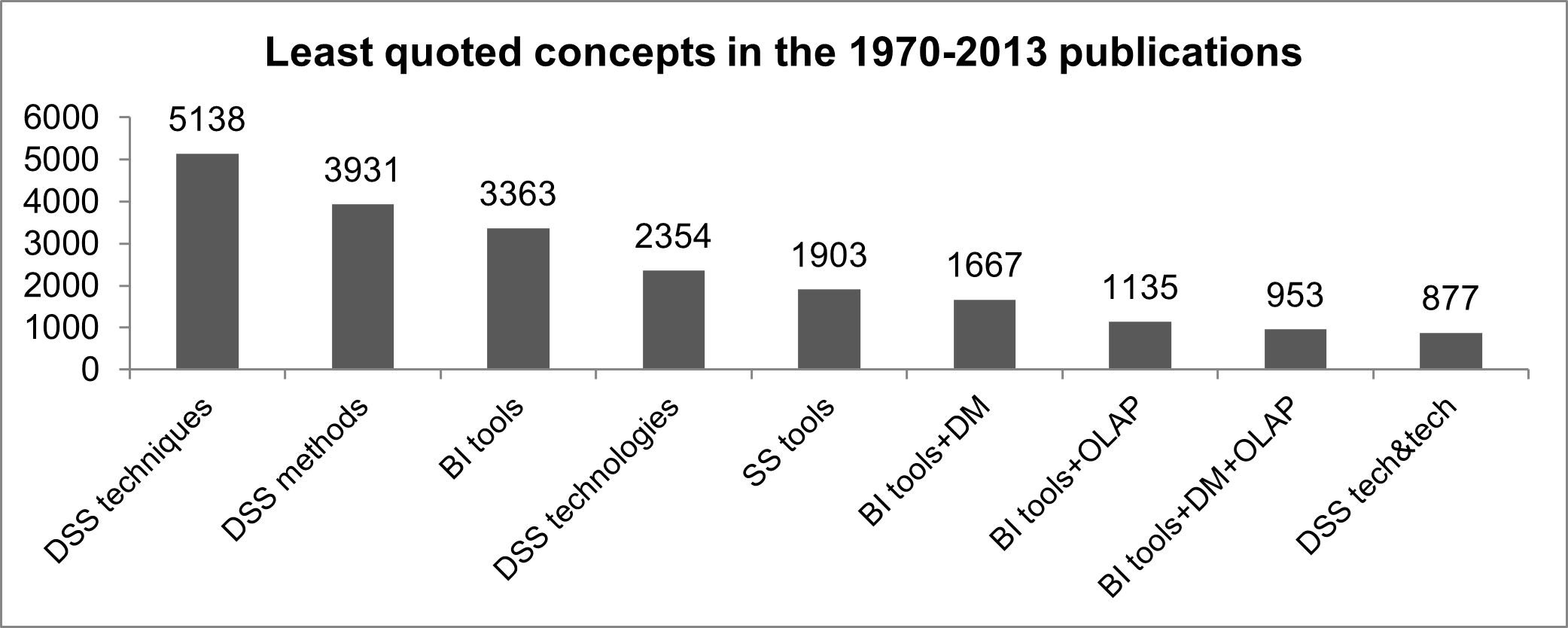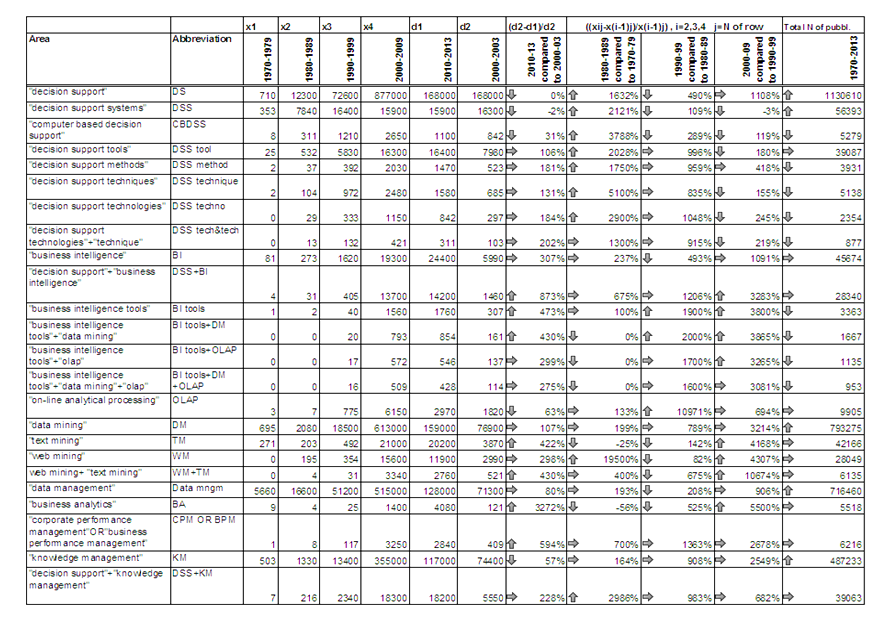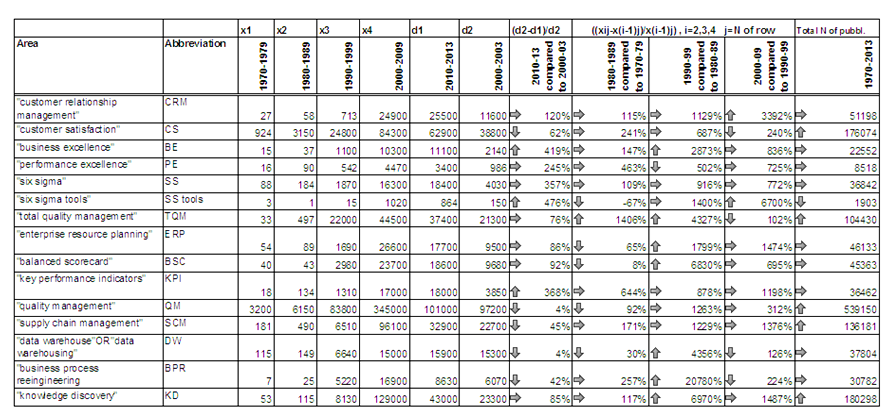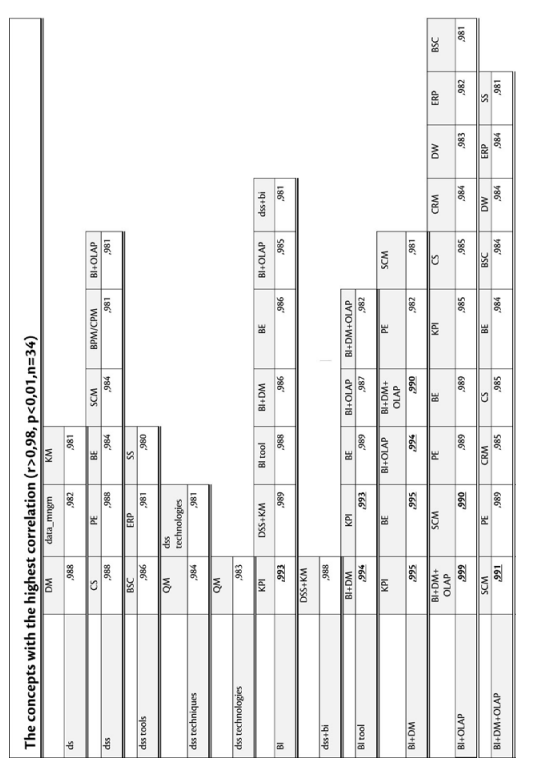1. INTRODUCTION
Today’s business is exceptionally dynamic: shorter product life cycles, distributed units of companies, complex supply chains, strong competition on a global level, enormous overflow of information, accelerated ICT development. Managers should continuously adjust to competitive challenges and seek new ways of exploiting technology to act faster and smarter, bearing in mind the satisfaction of clients and other participants (Power, 2013) . Though the development of technology could become an obstacle for managers, knowledge of new technologies and the context of their usage will become a basic solution to manager’s problems. Given the above, in the technological environment of modern organizations, comprised of computers, mobile devices, Internet, wireless communications, managers should make decisions that will enable competitive position of their companies. Basic concepts that support decision making are different definitions, facts and principles of how to use information and communication technology in the decisionmaking process. Understanding of these basics helps managers to evaluate and implement necessary software, a crucial step in the future successful business. Manager possessing the required knowledge uses the potential of the Business Intelligence analytic tools, as well as the functionality of decision support software, adjusted to specific business situations with the help of a technological specialist. The aim of the paper is to give managers a list of key terms in the domain of decision support and Business Intelligence that will help them acquire adequate knowledge for performance of their business function. The paper will categorize concepts into technical and managerial ones, with technical concepts implying the domain of specific tools and methods which should be thoroughly understood by technical specialists and not managers, while concepts in the managerial category will include meaningful connecting of the essential areas, approaches and philosophies, whose understanding is required for implementation of the best Decision Support System that will enable business excellence. Managers should understand concepts of the technical category to the extent that they can successfully realize purchase of an adequate software solution and choose adequate profile and number of professional personnel. There are several areas that stand out for their wide domain and are analyzed in numerous publications, ( Luftig, Quellete, 2012 ; Porter, Tanner, 2004 ), durable existence in business and academic environment and proven importance in understanding of all other related concepts (Turban, Sharda, Delen, 2011) . The paper continues with the overview and the analysis of chosen concepts, their development and connection to other domains.
2. BUSINESS EXCELLENCE AND TOTAL QUALITY MANAGEMENT
In the conditions of modern business described above, many organizations have adopted a set of methods that improve different organization levels and business aspects. The involvement of all employees in continuous improvement and transformation of business processes, with a view to realizing different user demands is of paramount importance when it comes to striving to improve quality and excellence. Concepts improvement and excellence include detailed knowledge of present conditions of certain process, project and company as a whole, precise and regular measurements and analysis and development of actions needed for improvements. During the eighties of the last century, many organizations recognized quality as a strategic factor for differentiating market companies, and not just for fulfilling the functional prerequisites in quality control. At the same time, basic understanding of quality changed and quality control gradually turned to efforts in providing quality, with the emerging acceptance of the ideas referring to managing the complete quality within an organization (Total Quality Management, TQM). TQM as an approach and philosophy had the greatest impact on the development of the field of business excellence. Presently, there are numerous business excellence models (Porter, Tanner, 2004) that companies use as the nucleus of their improvement and development in the fields of self-evaluation or external evaluation based upon TQM concepts, though supplemented with guidelines and requirements for better organizational integration. TQM is primarily considered as an approach focused on the improvement of effectiveness, efficiency, timely satisfaction of clients’ and other stakeholders’ needs by using employees’ skills and competencies with a purpose of achieving tested improvements in organization performances Porter, Tanner, 2004) . One of the critical success factors in TQM is strong leadership that motivates and authorizes employees to participate and engage. Organizations that implemented the TQM approach have outperformed their counterparts.
During the 90s of the last century, Business Process Reengineering (BPR) and Balanced Scorecard (BSC) developed as solutions that influenced development of different business excellence models. The main goal of BPR is to remodel crucial business processes due to decreased costs, increased product quality and better clients’ satisfaction. BSC is basically a measurement system, enabling an efficient translation of strategy into action. BSC tries to connect the dimensions of learning and developing employees with the efficient processes that provide quality products and services according to the dimensions of satisfying customer needs, and finally according to the financial dimensions. The influence of BSC on the excellence models can also be perceived, since they all include this conceptual frame. Six Sigma should also be mentioned as a group of methodologies whose application has rapidly increased during the last ten years. Six Sigma uses a set of techniques in collecting data and techniques for analyzing the same, trying to improve organizational processes. Approach is focused on modalities helping the organization to deliver its products and services faster, better and cheaper, influencing the improvement of process capability by fulfilling a higher number of user demands. Six Sigma enables identification of costs not influencing added value, neither for clients nor those processes influencing the key product characteristics from the user’s standpoint.
Some companies combined these initiatives with BSC initiatives due to the increased possibilities of progress enabled by the Six Sigma initiative. This helped to directly connect companies’ quality initiatives with their strategic goals. The same principle was used by Gupta (2007) when developing a hybrid methodology named Six Sigma Business Scorecards that underlines differences between these methodologies and the need for their integration. Shortly, BSC is focused on improving the strategy, while Six Sigma is focused on process improvement. Due to these differences, most companies treated BSC and Six Sigma as individual initiatives, though Leahey (2005) claimed that true advantages cannot be realized unless both concepts are integrated.
The key dimensions of areas related to Business Excellence, as described by Porter and Tanner (2004) , are as follows: Leadership, Focus on Clients, Strategy Alignment, Learning, Development and Innovations, Focus on Employees, Development of Partner Relationships, Process Management Based on Facts, Focus on Results and Social Responsibility.
3. DECISION SUPPORT AND BUSINESS INTELLIGENCE
The purpose of this paper is not to describe development of the concept of decision support, but instead to connect crucial concepts elaborated in the paper. Holsapple (2008) describes, in a comprehensible way, Decision Support System as a computer based system that represents and analyses knowledge from the aspects that ensure decision support procedures to be more productive, agile and innovative. Apart from the fact that it can be treated as digital knowledge storage, DSS enables acquisition of additional knowledge from external sources, focus on choosing the internal knowledge, generating new knowledge that could influence decisions, representation of knowledge through desired formats, coordinating outflow of knowledge among decision makers, controlling and the integrity/safety of outflows, and evaluation of participants and decision processes as a basis for future improvements.
Among Decision Support Systems, special attention should be given to decision making. To be able to understand decision making, one should understand the importance of information and knowledge processed according to that information. Knowledge management is related to distribution and assemblage of knowledge, while acquiring new knowledge refers to techniques of collecting and analyzing data and information. The authors Bolloju, Khalifa and Turban (2002) perceive the importance of integrating the Knowledge Management (KM) processes within Decision Support System so that decision makers can combine different types of knowledge (explicit and tacit) and data (internal and external), available in different formats.
When defining and describing Business Intelligence System (BI or BIS), one should start with information, one of the most important business resources, though their value is only potential. If companies want to use information to be successful, they should exploit them within the business processes for more quality decision making, processes performing and satisfying customers’ demands (Prajogo, McDermott, 2005) .
There are numerous definitions and descriptions of the BI or BIS concepts, e.g. Negash (2004) who defines BI as a system that combines data gathering, data storage, and knowledge management with analytical tools to present complex internal and competitive information to planners and decision makers; (Azvine, Cui and Nauck, 2005) for Azvine et al. (2005) BI is all about how to capture, access, understand, analyze and turn one of the most valuable assets of an enterprise — raw data — into actionable information in order to improve business performance. Lönnqvist and Pirttimäki (2006) stated that the term, BI, can be used when referring to the following concepts: 1. Related information and knowledge of an organization, which describe the business environment, the organization itself, the conditions of the market, customers and competitors and economic issues; 2. Systemic and systematic processes by which organizations obtain, analyze and distribute the information for making decisions about business operations; Turban and associates (2008) shortly and generally describe Business Intelligence as an umbrella term that combines architectures, tools, databases, analytical tools, applications, and methodologies. For the purpose of encompassing the complete domain and meaning of BI, authors propose the following definition: Business Intelligence System includes collecting and storing of comprehensive, correct and timely data that are converted through different tools and techniques to information and submitted to decision makers in the appropriate format, so they could subsequently, supported by this information, act according to the strategic goals.
This definition is supported by the claim that successful implementation of Business Intelligence System within a specific company is related to using the correct, updated and valid, integrated data as means that will transform data into information required for decision making (Zeng et al., 2006) .
The interrelated functioning of huge integrated enterprise systems such as Enterprise Resource Planning (ERP), Customer Relationship Management (CRM), and Supply Chain Management (SCM) systems with DSS and BIS is presently an exceptionally important field, where the Business Intelligence analytics developed upon integrated databases of the whole company can directly influence better, updated and flexible decision support, while decisions will subsequently influence the efficiency of CRM and SCM.
4. CONCEPTS RELATED TO THE SYSTEMATIC UNDERSTANDING OF DECISION SUPPORT AND BUSINESS EXCELLENCE
One of the goals of this paper is understanding and implementation of system thinking in certain areas related to the Decision Support Systems, such as acquiring the knowledge of the complete relevant system before considering its parts. Kanji (2005) claims that this attitude is opposed to the majority of modern managers’ philosophies and actions. Most companies are divided into sectors, departments, sections, with managers perceiving their segment of organization as an entity itself, so they try to improve and optimize only their segment of organization (sub-optimization), which leads to more damage than benefits. Optimization implies defining the best balance for the complete system or organization, while sub-optimization connotes optimizing a part of the system without guaranteeing the improvement of a whole. What is crucial in the center of system thinking of an organization are the relationships and connections within the organization and between the organization and the environment. Hence, main inputs, processes, outputs and feedbacks should be well perceived. Main inputs (e.g. humans, materials, equipment and money) should be processed into main outputs (e.g. products and services, fallouts), all of this coordinated and managed through the implementation of business policies, supported by adequate measurements, decision making and execution of actions. One of the major advantages of system thinking is the capability of understanding a large number of mutual relationships between system’s parts that will improve goal setting, implementation of policy and organizational structure. According to this standpoint, several concepts have been chosen and used as the basis for this paper.Table 1 presents a list of chosen areas, description of the purpose of knowledge of a specific area and its relation to other areas, and a category (managerial or technical). Knowledge categorized as managerial is required for the consciously, optimally and purposely used analytic and technical tools and methods (areas categorized as technical). Both categories are intended for all individuals interested in understanding a wider area encompassed in the paper. On the other hand, managers need not necessarily understand the described tools in detail in order to be able to successfully decide and manage.
Source: authors
5. RESEARCH METHOD
The research was conducted in several stages. During the first stage, the frequency of quoting the described concept or a combination of several concepts was observed over decades, i.e. throughout the 1970-2013 timeline. Research was done through Google Scholar. Quotes and patents were excluded, and the advanced search option was not used because the idea was to examine the frequency of quoting the concepts in all sorts of publications. The concepts used in search tools were combined with the operator OR, which indicated browsing of publications containing at least one of the concepts in their title, while each concept in the expression had quotation marks, thus specifying publications closely related to the context. The second research method included expressions given by the combination of two and more concepts with the quotation marks and the operator +, thus aiming to encompass all publications containing all of the mentioned terms. Considering the current year 2014, the observation of the last decade was limited to the 2010- 2013 period, while the escalations in frequency of the observed areas were compared to 2000- 2003 (inAppendix 1 marked as (d2-d1)/d2, in the form of percentage). Other annual ranges were analyzed as well, as it can be seen inAppendix 1. Decision Support Systems, data management, and quality management date back to the 1970s. Hence, 1970 was taken as the starting year. The aim of the first part of the research was to show the dynamics of the observed areas through a longer period of time – a decade, for which analyses of their frequency in publications of unspecified category were conducted, and to show the velocity of development of given areas as a percentage of frequency differences during a decade (equation given in the table as
, i=2,3,4 j=number of rows).6. RESEARCH RESULTS AND DISCUSSION
InAppendix 1 three arrows were used to demonstrate the three categories of the velocity of concept development, while each column containing arrow was regarded as a whole when determining percentiles. Upward arrow demonstrates concepts developing at a speed higher than the 75th percentile; the right arrow demonstrates concepts of an average speed between the 25th and 75th percentile, while the down arrow refers to the concepts developing at the slowest rate in a given period of time, with the speed average below the 25th percentile. It should be underlined that the above mentioned categories, i.e. arrows, show the velocity of concept development in comparison to other concepts of the time, while the development of individual concepts should be analyzed through rows, e.g. the concept of “balanced scorecard” recorded the speed of quotations of 8% in the 1980-1989 publications compared to the 1970-1979 period when it was among the slowest developing concepts (down arrow). During the period of 1990-1999 it increased a total number of quotations by 68 times, in comparison to 1980-1989, or 6830%, with arrow upwards implying that, aside from other concepts analyzed in the same period, it recorded one of the highest increases of frequency. The term “balanced scorecard” was, during the 1990- 1999 period, one of the most quoted concepts used within different publications.Appendix 1 also clearly indicates chronological growth of quotation frequency for all the considered concepts, showing the relevance of all observed concepts in terms of scientific and business perspective.Graph 1 displays the most quoted concepts in the 1970-2013 publications.
In the following illustration,Graph 2, the concepts with least frequency recorded in the same period were displayed.
Graph 3shows an overview of the crucial areas related to managerial category, or, in certain examples, to managerial and technical category. Two periods were considered since they were crucial for the development of the observed concepts. BPR recorded a significant increase of frequency in 1990-1999, in comparison to 1980-1989, alongside TQM, BE, ERP and SS, as the most quoted concepts in the same decade. The other concepts recorded a higher increase of frequency during the period 2000-2009 in comparison to 1990-1999, than during the period 1990-99 in comparison to 1980-1989.
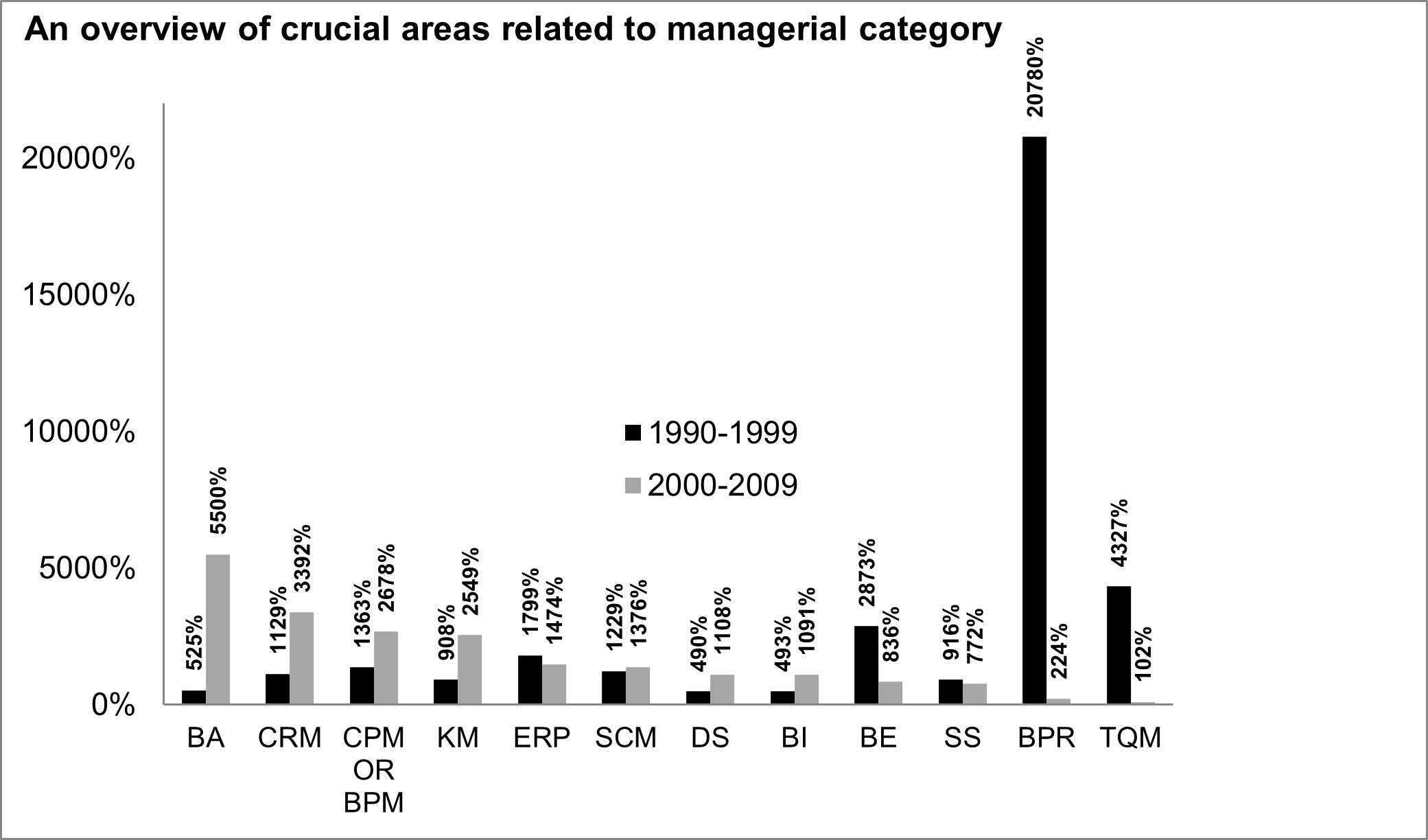
Source: authors
Graph 4 was designed on the same principle displaying the concepts categorized in technical category, due to the functionalities of processing, modeling, storing, measuring etc. It can be noticed that in the 2000-2009 period, in comparison to the previous decade, the most developed areas were WM+TM (+ denoting publication containing both concepts), SS tools, BA, following WM and TM as individual concepts, BI tools and DM, while other concepts recorded the highest growth in the 1990-1999 period.
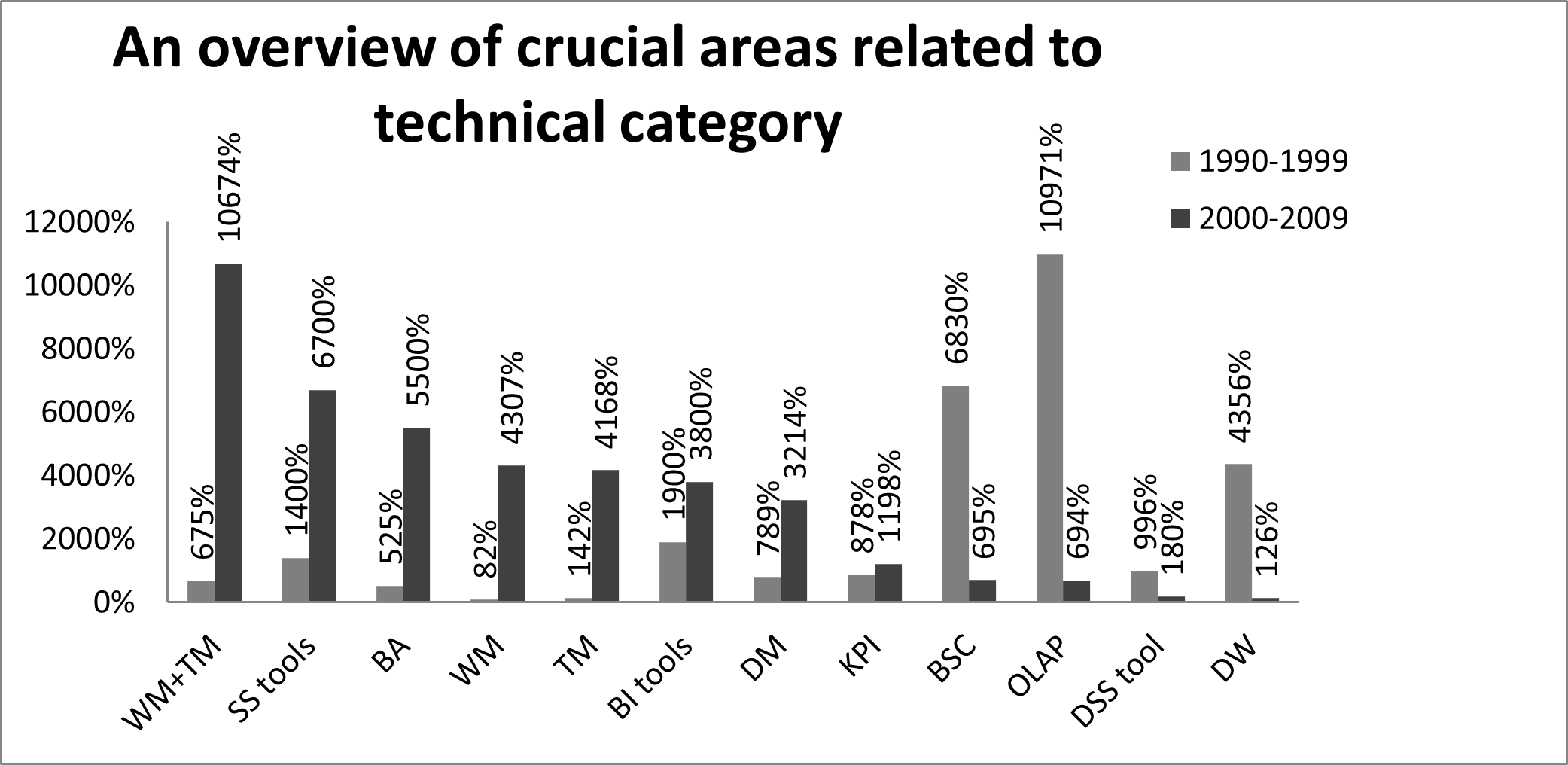
Source: authors
Graph 5 shows increase of concepts included inGraphs 3 and4, referring to the interrelation between triennial figures about frequency starting from 2010-2013, in comparison to 2000-2003. It can be concluded that BA recorded the highest increase, followed by CPM/BPM, SS tools, BI tools, WM+TM, Tm, BE, KPI, SS, BI.
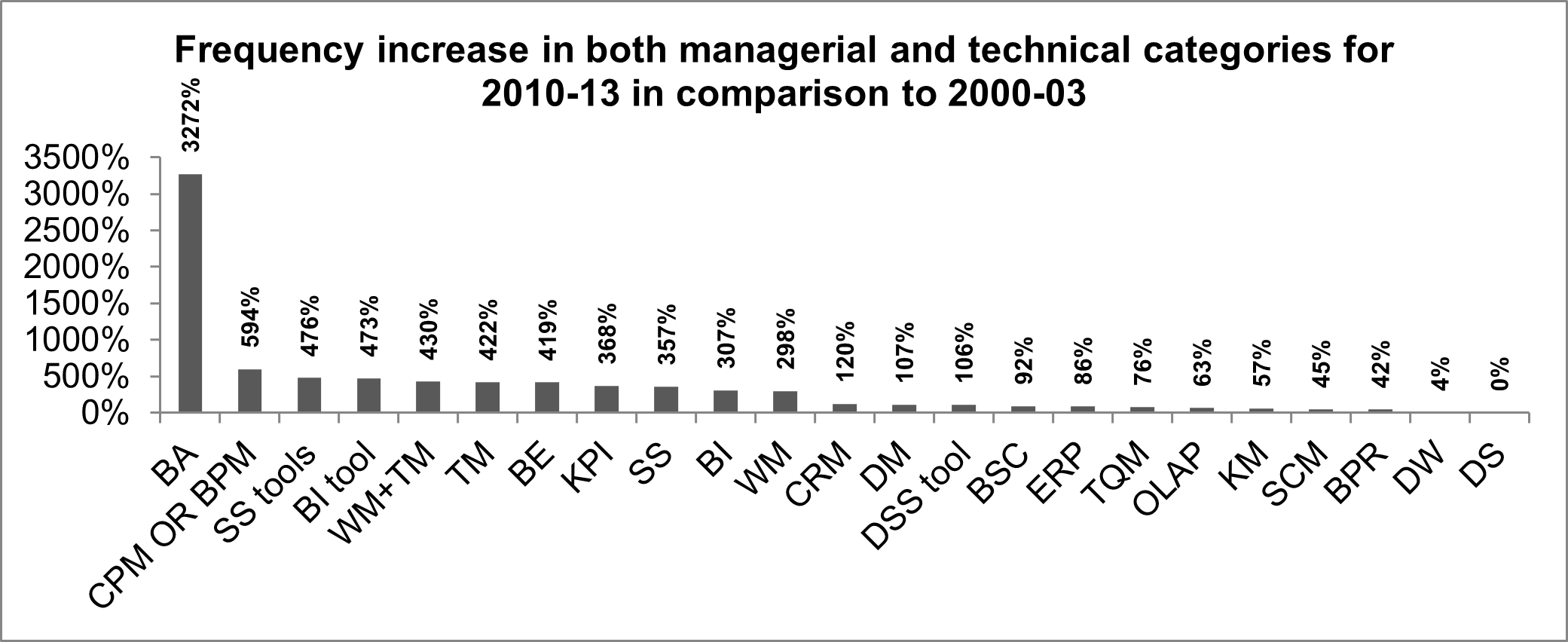
Source: authors
In order to specify the concepts most frequently quoted in publications edited in the recent period 2010-2013,Graph 6 was prepared to show their frequency. It can be concluded that the concepts DS, DM and KM are evidently more frequently quoted in the recent publications, followed by the concepts TQM, SCM, CRM, and BI.
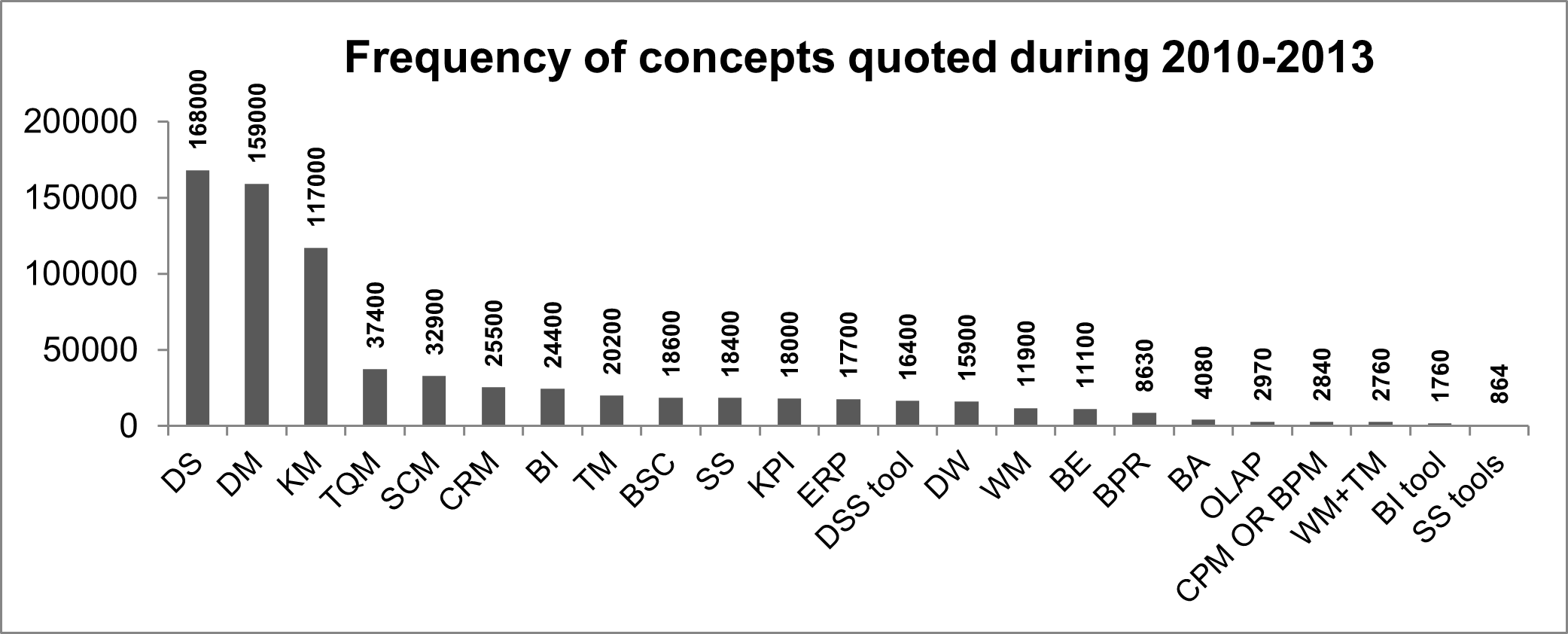
Source: authors
The second part of the research analyzed the frequency of quotations for concepts named inAppendix 1 , separately for each year in the 1980-2013 period, summing up 34 years, with a purpose of specifying the most correlating concepts (the ones with the most similar frequency dynamics). For this purpose, the SPSS software was used, the version 19, combined with the correlation analysis and correlation matrix containing all concepts. The prepared matrix was used to extract correlations with r>0.98 and p<0.01, which were displayed inAppendix 2. The correlations with r>0.99 were underlined and written in bold fonts, which has helped to highlight the highest correlation between the concepts, as shown inTable 2.
Source: authors
7. CONCLUSION
This paper offers an insight into areas mutually connected by the fact that their domain is interrelated in order to achieve business excellence in all aspects of business: processes, products, clients and the environment. The motivation behind this standpoint comes from the fact that the research area is exposed to a multitude of concepts, philosophies, approaches, methods, tools, and techniques, so there is a need for a certain guidebook-overview offering the list of areas whose knowledge (detailed or general, depending on the function of employee or interested reader) is essential in understanding the complete business reality of modern times. As it was mentioned in the first chapters, several concepts address a wider domain (BE, TQM, DSS, BIS) than others, so these were used as basics when observing the interrelations to the other concepts. Browsing, storing, analyzing, interpreting and application of information for quality decision making and acting is a simplified course of the business cycles. The choice of software solutions, methods, material resources, and profiles of employees who will participate in the system is made by personnel holding the highest positions in a company, so their knowledge and competence is a required prerequisite for achieving the business excellence. This necessity was substantiated in the second and the third chapter of this paper.
The research results were used to describe the frequency of quotations for chosen concepts through several periods of time so as to determine which concepts developed most rapidly and to what degree they are more represented or “popular” in a certain time period than others. The authors noted that concepts related to the technical category (Table 1 ) mostly developed after 2000, their frequency being lower than that of theoretical concepts belonging to the managerial category, while technical concepts were leading in terms of percentage increase in the 2010-2013 period when compared to 2000-2003 (Graph 5). This conclusion implies that the frequency of certain concepts in publications is not the absolute measure of their relevance and importance, with the percentage increase between time periods being an equally important indicator, especially considering the last decade.
The second part of the research evaluates the correlation of chosen concepts, and the latter are extracted inAppendix 2 displaying the couples of concepts achieving the correlation r>0.98, p<0.01, and separately displayed couples correlating r>0.99 (Table 2). The correlations indicated that areas chosen in the paper are strongly interrelated, thus making one system that should be regarded as a whole, but separately as well.
Future research will be directed toward formalization of knowledge requirements for Business Intelligence department employees, which will facilitate personnel recruitment and targeted education of employees.

